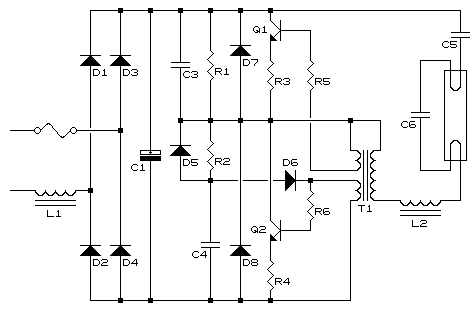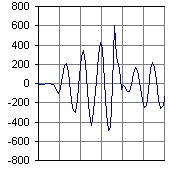|
Another name for such lights are "Compact Florescent Lamps". Their claim to fame, even though they are more expensive than filament types, is their lower running costs coupled with expected long life thus justifying the extra expense. These lamps are prone to failure and is expressed as a life far shorter than published. The following is based on an investigation where about 30 such lamps were being used in a site, the complaint being they were lasting about a tenth of their expected life. The lamps were a mixture of 3W, 7W, 11W, and 15W.
The first action was to copy out the circuit, this is shown above. However, it proved to be of little use as most of the faults were not related to the components at all, but will be shown to be the circuit as a whole that was at fault. Two main causes were found to be the root of failure. The first was operating conditions, the second was type related.
The largest wattage lamps were the only to suffer electronic component damage, and one lamp simply "falling apart" when opened. None had blown the fuse or any input diodes, but had blown both transistors and surrounding passive components. Transistors usually fail in this way when subjected to over voltage, this easily being attributed as the cause. When these were carefully inspected, there were clear indications of condensation within the compartments that housed the electronics. On one lamp there were clear signs of corrosion on the tube wires (copper turned green and came adrift from the tube) and water having been absorbed on the printed circuit board. What was noticed about these lamps is they were operated hanging down, with water marks inside the circuitry compartment showing which way the water had gathered. It was suspected these were hanging over a place where there was a lot of water vapour or steam and having gathered on the board and damaging the circuitry / lamp. These are not sealed units and cannot be used in such an environment. There are vent holes in the form of slits just where the bayonet cap joins the plastic housing. Any water collecting on the circuit board will cause extraneous currents to flow, damaging sensitive components.
This was the majority of the lamps that failed and they were all the same type. There were no electronics failures in any of these lamps. The fault in each was the tube became blackened within a few hundred hours of use and then suffered catastrophic tube failure with one of the filaments burning open, this being shown by the side where the tube is more black. This failure showing the filament was burning at a higher than normal temperature. What caused suspicion was the manufacturer claiming a running voltage of 240V 50Hz or DC. Now, something smells a bit as 240VAC = 339VDC. What caused a little worry is had they built these for another industry and hoped they would also work in domestic use!? Tests were conducted on a new lamp. The overall tube current, conduction current, and filament current were all tested under varying input voltages. The range was 230VAC -5..+10% (simulating close to EN50160 limits)
This decreased as the voltage increased with an overall change of approximately -4% for the full 15% change in input range. This was attributed to the waveform changing shape and less current flowing through the capacitive coupling that exists between the two filaments.
Here, the current increased by 36% for 15% change in input voltage. Although the lamps are marked at 240V, having them run at 253V meant an extra 15% tube current and this is sufficient to drastically reduce the tube life.
This current increased at the same rate (in current) as the conduction current meaning it proved that the conduction current was reasonably accurately measured.
The inrush through the filaments reaches a whopping 600mA peak (as opposed to 66mA running). This is approaching an inrush ratio of 10:1. Any short duration loss of power (such as a faulty switch or loose contact) would not damage the filament, but turning the lamps off and on would drastically reduce filament life.
With the medium wattage lamps (7..11W), it appears there is a good balance between well designed circuits and tubes that can handle the extra currents that could be imposed on the tube under higher operating voltages. Even when operating at +20% over nominal, the lamps showed no signs of strain after 1000 hours of use. Our exposure to high wattage lamps (15W) showed they were susceptible to failure when asked to run in adverse conditions such as areas where high levels of water vapour is experienced. They are thus regarded as unsuitable for above cookers, inside fridges, etc. These lamps did show reasonable life even when operated at slightly higher than nominal voltage. Finally, it appears as if certain types have a high intolerance to overvoltage. One would see degradation when the input voltage is on the high side. The filaments would also start to take severe strain once the gas in the tube begins to deplete when subjected to high working currents from high input voltage.
© 16.08.03 |
 SYMPTOMS:
SYMPTOMS:
 Filament Inrush:
Filament Inrush: